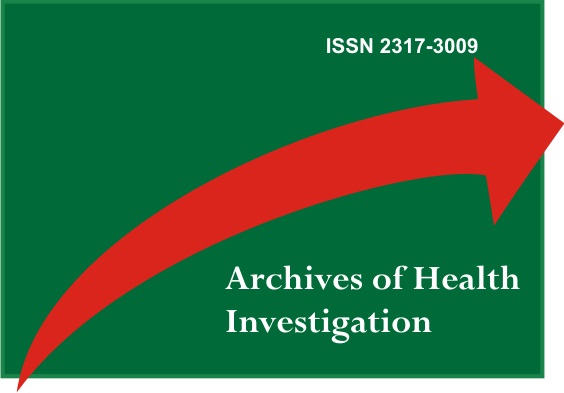Analysis of facial typology using Ricketts Vert Index and the Facial Index
DOI:
https://doi.org/10.21270/archi.v10i6.5033Keywords:
Indexes, Orthodontics, AnthropometryAbstract
This study aimed to evaluate the agreement in the diagnosis of the facial typology of patients undergoing orthodontic treatment, through lateral cephalometric measurements in the Ricketts Vert Index and the Facial Index. The sample consisted of 60 individuals of both sexes, over 18 years old, belonging to the postgraduate course in orthodontics of the FIP (Integrated Faculties of Patos - PB, Brazil), evaluated by means of direct anthropometry (Facial Morphological Index) and indirect anthropometry (Ricketts Vert Index). The results were statistically analyzed using the weighted Kappa coefficient. Poor agreement was obtained between the two methods in determining facial type. It was concluded that direct anthropometry, a method consolidated as an important resource in determining facial type from facial height and width, did not find agreement with the Ricketts Vert Index values.
Downloads
References
Queiroz GV, Rino J, Paiva JB, Capelozza L. Analysis of reliability, accuracy, sensitivity and predictive value of a subjective method to classify facial pattern in adults. Dental Press J Orthod. 2016;21(6):58-66.
Benedicto EN, Kairalla SA, Kaieda AK, Miranda SL, Torres FC, Paranhos LR. Determinação do padrão esquelético vertical da face. Rev Bras Cir Craniomaxilofac. 2011;14(1):44-9.
Rocha TL, Pinzan A, Bronfman CN, Henriques JFC, Janson G. Estudo cefalométrico comparativo da análise de Ricketts para jovens brasileiros leucodermas, melanodermas e mestiços (feodermas) com oclusão normal. Ortodontia. 2015;48(2):168-78.
Quintão APA, Vitral RWF. Estudo comparativo entre cefalometria manual e computadorizada (análise de Steiner, Tweed e Downs) em telerradiografias laterais. HU Rev.2010;36(2):95-9.
Claro CAA, Abrao JR, Braga SA. Association between overbite and craniofacial growth pattern. Braz oral res. 2010;24(4):425-32.
Ricketts, Robert M and Rocky Mountain Data Systems Orthodontic diagnosis and planning: their roles in preventive and rehabilitative dentistry. Rocky Mountain/Orthodontics, Denver, Colo; 1982.
Ramires RR, Ferreira LP, Marchesan IQ, Cattoni DM, Silva MAA. Medidas faciais antropométricas de adultos segundo tipo facial e sexo. Rev CEFAC. 2011;13(2):245-52.
Furtado IA, Agostinho HR. Apresentação do Método Anátomo-Clínico de Faciometria Directa em Crianças com Objectivos Propedêuticos. Acta Med Port. 2014;27(4):458-66.
Sies ML, Farias SR, Vieira MM. Respiração oral: relação entre o tipo facial e a oclusão dentária em adolescentes. Rev Soc Bras Fonoaudiol, 2007;12(3):191-98.
Rakosi T, Jonas I, Graber TM. Exames clÌnicos especiais. In: Ortodontia e ortopedia facial: diagnÛstico. Porto Alegre: Artmed; 1999.
Ahmed M, Shaikh A, Fida M. Diagnostic performance of various cephalometric parameters for the assessment of vertical growth pattern. Dental Press J. Orthod. 2016;21(4):41-9.
Perez I, Chavez AK, Ponce D. Applicability of the Ricketts' posteroanterior cephalometry for sex determination using logistic regression analysis in Hispano American Peruvians. J Forensic Dent Sci. 2016;8(2):111-25.
Bavia PF, Vilanova LSR, Garcia RCMR. Craniofacial Morphology Affects Bite Force in Patients with Painful Temporomandibular Disorders. Braz Dent J.2016;27(5):619-24.
Rosa APB, Rodrigues EG, Torres FC, Comar LP, Alonso MBCC, Triviño T. Correlação entre as formas dos arcos dentários e os tipos faciais. Arch Health Invest. 2016;5(Spec Issue 6):10.
Golalipour MJ, Haidari K, Jahanshahli M, Frahani, MR. The shapes of head and face in normal male newborns in South- east of Caspian Sea(Iran- Gorgan). J Anat Soc. 2003; 52(28):31-43.
Berwig LC, Figueiredo FSP, Bolzan GP, Milanesi JM, Marquezan M, Busanello-Stella AR et al. Medidas antropométricas orofaciais de crianças segundo o tipo facial. Rev CEFAC. 2017;19(1):63-8.
Nascimento WV, Cassiani RA, Dantas RO. Efeito do gênero, da altura corporal e da etnia nas medidas antropométricas orofaciais. CoDAS. 2013;25(2):149-53.
Bolzan GP, Berwing LC, Prade LS, Weinmann ARM, Moraes AB, Silva AMT. Concordância entre o método antropométrico e cefalométrico na classificação do tipo facial. Rev CEFAC. 2014;16(1):222-27.
Roque-Torres G, Meneses-López A, Norberto-Bóscolo F, De Almeida SM, Haiter-Neto F. La tomografía computarizada cone beam en la ortodoncia, ortopedia facial y funcional Rev Estomatol Herediana. 2015;25(1):61-78.
Haiter-Neto F, Oliveira SS, Casanova MS, Caldas MP. Telerradiografias obtidas em posição natural da cabeça alteram as grandezas cefalométricas? Rev Dent Press Ortodon Ortoped Facial. 2007;12(4):117-23.
Bedoya A, Osorio JC, Tamayo J.A. Biotipo morfológico facial en tres grupos étnicos colombianos: una nueva clasificación por medio del índice facial. Int J Morphol. 2012;30(2): 677-82.


